Human Teeth Dental Charts
As the most awarded Bradford dentist we are proud to offer you the resources about dentistry, teeth and oral health. As a leading Bradford dental clinic, we offer a full range of dental services including: dental implants, dental veneers, dental crowns, root canals, braces and much more.
The human teeth dental chart illustrates the location and roles each tooth plays in performing their jobs of cutting, grinding and crushing food. Teeth differ in size, shape and their placement in the jaws. These variations allow teeth to work together to help you chew, talk and smile as well as to help shape your face, giving it its form.
Primary Human Teeth Dental Chart (Baby teeth)
A. Right maxillary 2nd primary molar
B. Right maxillary 1st primary molar
C. Right maxillary cuspid
D. Right maxillary lateral
E. Right maxillary central
T. Right mandibular 2nd primary molar
S. Right mandibular 1st primary molar
R. Right mandibular cuspid
Q. Right mandibular lateral
P. Right mandibular central
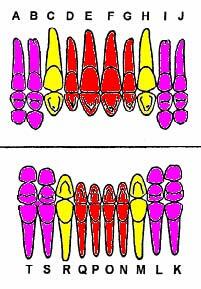
F. Left maxillary central
G. Left maxillary lateral
H. Left maxillary cuspid
I. Left maxillary 1st primary molar
J. Left maxillary 2nd primary molar
K. Left mandibular 2nd primary molar
L. Left mandibular 1st primary molar
M. Left mandibular cuspid
N. Left mandibular lateral
O. Left mandibular central
At the time of birth, tooth buds are already in place. Babies typically have 20 primary (baby) teeth, which usually begin to erupt typically around 6 months of age but can be anywhere between approximately 3 months of age until 12 months to begin the accommodation of solid foods and the change in baby’s diet. The above human teeth dental chart are of children’s 20 primary teeth.
Cutting teeth takes time and can be painful for babies, which is usually completed by the age of 3. Teeth start to fall out at various times throughout childhood and by the age of 21; all 32 of the permanent teeth have usually erupted.

Eruption of Primary Teeth Dental Chart
Usually, humans get two sets of teeth during a lifetime. The first, primary or deciduous set is comprised of the 20 “baby” teeth. The second permanent set usually consists of 32 teeth. In each quadrant, there are eight permanent teeth including two incisors, one cuspid, two bicuspids, and three molars.

Eruption of Permanent Teeth Dental Chart
The pictorial below of permanent human teeth can help you to understand the positioning of each of your 32 permanent teeth in an adult mouth. The last teeth to arrive are the three molars. The third molars are more commonly referred to as the “wisdom tooth.”

Tooth Chart Positioning
The upper teeth of arch on the human teeth dental chart are called maxillary teeth because their roots are placed within the upper jawbone of the maxilla. Those of the lower arch are called mandibular teeth because their roots are embedded within the lower jawbone of the mandible. Each arch contains 16 teeth, composed of 6 anterior, and 10 posterior and in a quadrant, there are 3 anterior and 5 posterior teeth.
On this human teeth diagram, there are four classes of teeth, incisors, cuspid, bicuspid and molars, based on appearance, position and complementary functions.

A tooth is a hard, bony appendage that develops on the jaw to pulverize food. In man, the design of the teeth is a reflection of eating habits, as humans tend to be meat eaters so teeth are formed for cutting, tearing, and grinding food.
The human teeth dental chart illustrates the types and working surfaces of the four classes of teeth.
A tooth is a hard, bony appendage that develops on the jaw to pulverize food. In man, the design of the teeth is a reflection of eating habits, as humans tend to be meat eaters so teeth are formed for cutting, tearing, and grinding food.
The human teeth dental chart illustrates the types and working surfaces of the four classes of teeth.
Incisor Teeth
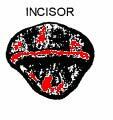
On the dental chart, incisors are located in the front of the mouth and have sharp, thin edges for cutting. Their use is to incise or cut food and the appearance tends to have a shovel-shaped appearance.
Cuspid Teeth
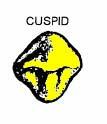
Cuspids, also referred to as canines, are at the angles of the mouth on the tooth chart. Each has a single cusp and is designed for cutting and tearing.
Bicuspid Teeth
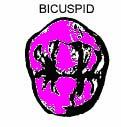
Bicuspids, also referred to as premolars, are similar to the cuspids. They have two cusps used for cutting and tearing, and a wider surface to bite and crush food.
Molars
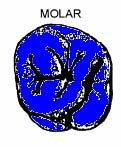
Molars are located in the back of the mouth. Their size gradually gets smaller from the first to third molar. Each molar has four or five cusps, is shorter and more rounded in shape than other teeth and has a broad surface for grinding and chewing solid food.
When viewing the human teeth dental chart, it shows the typical human mouth. People are all different and do not always have every tooth come in or they may appear at different times. When extractions or exclusions occur, depending on the tooth, different methods can get chewing accomplished.
Although your teeth may not be identical to the human teeth dental chart, we can create a smile you can be confident and proud of, while meeting the functions required. Please contact us to discuss any issues concerns or maintenance you may need addressed.
If you live in any of the following areas and would like to book an appointment to see your human teeth dental chart for free, please call us at: 1-877-283-0497 in:
Check Out Our Latest Articles
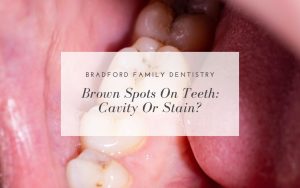
Brown Spots On Teeth: Cavity Or Stain?
Have you noticed brown spots on your teeth but aren’t sure what

Tips For Naturally Stronger Teeth
Strong teeth help reduce the risk of cavities and damage from everyday

Signs You Might Need Dental Implants
When you have missing teeth, the longer you live with the gaps,

Best Children’s Dentistry Near Me
Children’s dentistry requires a more “fun” approach in order to create an

Sleep Apnea Explanation And Treatment
Sleep apnea is a common condition that causes breathing to stop while

Best Family Dentistry Near Me
Finding the ‘best family dentistry near me’ is essential to enjoying healthy



